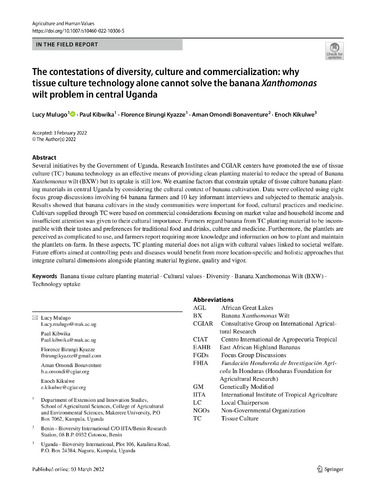The contestations of diversity, culture and commercialization: why tissue culture technology alone cannot solve the banana Xanthomonas wilt problem in central Uganda
Several initiatives by the Government of Uganda, Research Institutes and CGIAR centers have promoted the use of tissue
culture (TC) banana technology as an effective means of providing clean planting material to reduce the spread of Banana
Xanthomonas wilt (BXW) but its uptake is still low. We examine factors that constrain uptake of tissue culture banana plant-
ing materials in central Uganda by considering the cultural context of banana cultivation. Data were collected using eight
focus group discussions involving 64 banana farmers and 10 key informant interviews and subjected to thematic analysis.
Results showed that banana cultivars in the study communities were important for food, cultural practices and medicine.
Cultivars supplied through TC were based on commercial considerations focusing on market value and household income and
insufficient attention was given to their cultural importance. Farmers regard banana from TC planting material to be incom-
patible with their tastes and preferences for traditional food and drinks, culture and medicine. Furthermore, the plantlets are
perceived as complicated to use, and farmers report requiring more knowledge and information on how to plant and maintain
the plantlets on-farm. In these aspects, TC planting material does not align with cultural values linked to societal welfare.
Future efforts aimed at controlling pests and diseases would benefit from more location-specific and holistic approaches that
integrate cultural dimensions alongside planting material hygiene, quality and vigor.

